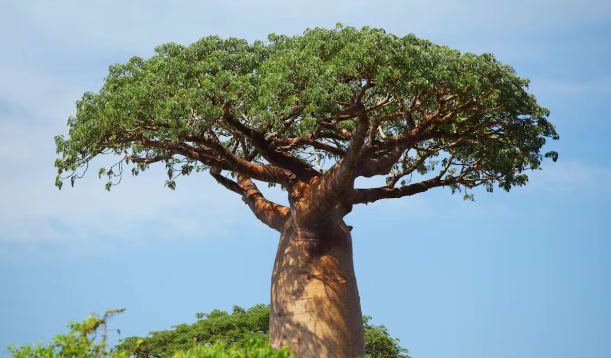Spiritual implications of felling baobab trees
By Jasmine.Atieno, December 14, 2022Radio carbon dating has revealed that the African Baobab species also known as the Adansonia Digitata, could be over 2,000 years old. This makes the tree, a symbol of life and positivity due to its ability to prevail even where little else can. Over time, the baobab has adapted to its environment. It is succulent, which means that during the rainy season it absorbs and stores water in its vast trunk, enabling it to produce a nutrient-dense fruit in the dry season when all around is dry and arid. This is how it became known as “The Tree of Life”.
In the coastal villages of Kenya, the Mbuyu (Baobab tree) is not only popular for its nutritional value, but the term ‘Tree Of Life’ becomes even more alive due to its close ties to the spiritual realms. It is never a strange scene walking right past a baobab tree, which serves as a shrine. It is also popular knowledge that mizimu (spirits) make homes of these ancient trees.
Unclear action
Recently though, news spread like wild fire of foreigners led by a Georgian national, Georgy Gvasaliya, who had been uprooting these age old trees from Kilifi community and exporting them to their country. So far, about eight trees are reported to have been uprooted. The unclear circumstances around these actions raised eyebrows of many people.
According to some concerned locals who came together to find a lasting solution to the sudden threat to the coastal ecosystem, this was an act of exploitation from the western community just like they do with cultural artifacts.
“Baobabs are not just ordinary trees that anyone can decide to cut down, they are also habitats for birds and other organisms, and the reasons the foreigners gave was just vague. Just their normal habit of taking from our motherland. Why uproot a 200-year-old tree? If you care about conserving the species as you say, plant the seeds,” shared Ciro Githunguri, an environmentalist and owner of Mizizi Bistro, a plant based eatery in Kilifi County.
She claims the foreigners were offering locals between Sh100,000 to Sh200,000, which might have felt like much to some of the poor locals, but definitely not worthy of a fully aged baobab tree. It is alleged that the trees were destined for the Shekvetili Dendrological Park.
The Kenya Forest Service had allowed the uprooting of the baobabs because the tree is not a protected tree species in the country and not on any appendices of the Convention on International Trade in
Endangered Species of Wild Fauna and Flora (CITES), a multilateral treaty to protect endangered plants and animals from the threats of international trade.
Lawrence Chiro, a conservationist under the Coastal Forest Conservation Unit, the organisation which looks after the Mijikenda Kaya Forests, shared that there was no full disclosure on the agenda of uprooting the trees.
“The locals don’t understand why our baobab trees are being bought. For what reason? For what use are they going to be put into. As of now, we are just guessing where our baobab trees were being taken to,” explained Lawrence during the discussion on the cutting down of the baobab trees and other trees around the county.
Link between world, spirit
What some locals might have considered a quick solution to their financial situation, Mijikenda elder, Biasha Kache intimates that it might bear much bigger consequences to the local community. The giant trees are not easily cut down to avoid destroying the residence of the spirits and hence offending them.
“Baobab trees are not supposed to be cut. It is an important link between this world and the supernatural world. Because of its age and other factors, baobab trees are used as shrines and linked with Kayas. For instance, during famine, elders will go for prayers, perform some rituals under specific baobab trees, so that people will receive rainfall. If you cut them down where will the elders go to pray?” she poses.
“The other spiritual use of the baobab trees is to eradicate evil from the community. For instance, people go to chase away evil spirits of death from a home. If a member of a family is involved in an accident and dies, during the mourning period the family will also shave their hair, and leave the shaved hair at the baobab tree. It is a way of communing with the spirit world, so that death will not visit the family in this way again,” she says of the Mijikenda traditional beliefs.
According to the female Mijikenda elder, cutting down of an old baobab tree has consequences of course. One of them being a visitation by a series of haunted dreams.
“The elders will pay you a visit to question your actions of course. Why would you cut down a tree, which has lived more years than your ancestors? And if you are the one who physically cut down the tree, you will not be able to have peaceful sleep after that. Your dreams will become a series of very haunted visitations by the mizimu,” shared Kache.
